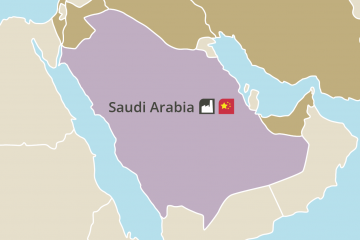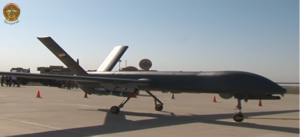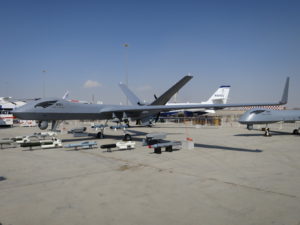
Saudi Arabia
With a fast jet fleet second only in capability terms to Israel in the Middle East, the Royal Saudi Air Force (RSAF) is not short of traditional means to conduct its long-running air campaigns. However, Saudi Arabia has also joined those countries that look at drone capability as an additional asset. In 2014, the country purchased two Chinese CH-4s, although these may well be the unarmed ‘A’ variant rather than the armed ‘B’, and five larger and more heavily armed Wing Loong IIs. In terms of imports, therefore, the Kingdom has purchased remarkably few armed UAVs in comparison to its huge purchases of fast jets and other high-end military equipment.
Nonetheless, it has announced ambitious plans to manufacture its own armed drones, obtaining a licence from the Chinese state-owned Chengdu Aircraft Industry Group (CAIG) to develop up to 300 Wing Loong and potentially CASC’s new heavyweight CH-5 armed UAVs.[1]
NOTE
[1] Joanna Frew, ‘Drone Wars: The Next Generation’, Drone Wars UK, May 2018, pp. 19–20; Stockholm International Peace Research Institute (SIPRI), ‘SIPRI Arms Transfers Database’.
Armed UAV inventory

Drone
CH-4B Rainbow
Type
Medium Altitude, Long Endurance (MALE) UAV
Manufacturer
China Aerospace Science and Technology Corporation (CASC)
Number
2
Endurance
Up to 40 hours depending on payload
Loaded Weight
4500kg
Payload Capacity
345kg
Range
>1000km with SatCom, ~150km from Ground Control Station (GCS) if not.
Sensor Options
Infra-Red (IR) and Electro-Optical (EO) cameras, and laser designator in sensor ball.
Weaponry
‘A’ Variant is Unarmed. ‘B’ carries up to 345kg of payload on 4-6 wing hardpoints including: the AKD-10 air-to-surface anti-tank missile, BRMI-90 90mm guided rocket, FT-7/130 130kg glide bombs, FT-9/50 50kg bomb, FT-10/25 25kg bomb, GB-7/50 50kg precision-guided munition (PGM), and GB-4/100 PGM.

Drone
Wing Loong II
Type
Medium Altitude, Long Endurance (MALE) UAV
Manufacturer
Chengdu Aircraft Industry Group (CAIG)
Number
5
Endurance
Up to 32 hours depending on payload
Loaded Weight
4200kg
Payload Capacity
480kg
Range
>1000km with SatCom, ~150km from Ground Control Station (GCS) if not
Sensor Options
Infra-Red (IR) and Electro-Optical (EO) cameras, and laser designator in sensor ball
Weaponry
Up to 480kg of payload on twelve wing hardpoints which can include: AKD-10 air-to-surface anti-tank missile; BRMI-90 90-mm guided rocket; FT-7/130 130-kg glide bombs; FT-9/50 50-kg bomb; FT-10/25 25-kg bomb; GB-7/50 50-kg PGM; and GB-4/100 PGM
Saudi Arabia operates the largest and most modern air force in the Arab world, with hundreds of state-of-the-art fast jets in the shape of modernised F-15S/SA Eagles and Eurofighter Typhoons. Consequently, the acquisition of armed drones seems to have been mainly driven by a matter of prestige and is linked to the Vision 2030 national development plans being spearheaded by the Saudi leadership to create a domestic defence industry, as part of a broader economic reform.[1] Armed UAVs, at least for now, have thus not led to a change in the way airpower is viewed in the country and their acquisition does not seem to be triggered by an existing operational requirement due to conceptual future operations.
Saudi Arabia has been heavily involved in air campaigns over the past four years against Daesh in Iraq as part of the US-led coalition and its own campaign against Iranian-backed Houthi rebel fighters in Yemen. It is the latter campaign which has absorbed most of the RSAF’s attention in recent years, and some of its growing drone forces have been seen stationed at Sharurah and Jizan airbases near the Yemini border.[2]
However, there is not a great deal of evidence of the RSAF’s use of Wing Loongs for regular operations over Yemen, with most attributing strikes suspected of being carried out by UAVs rather than fast jets to the UAE or the CIA’s own targeted assassination programme against Al-Qa’ida affiliates in parts of the country. This may be due partly to stiffening air defences being supplied to the Houthis by Iran – man-portable air defence systems (MANPADS) and even adapted Russian R-27T air-to-air missiles have been fired by ground forces with some regularity against Saudi fast jets and helicopter gunships, causing losses and damaged aircraft.[3]
A CH-4 UAV was filmed crashing in Yemen in August 2018, and another UAV in September 2018, both after being hit with a suspected MANPADS, although it is unconfirmed whether these were Saudi or Emirati airframes.[4]
As a large conventional air force, the RSAF appears to be mostly content with the status symbol of drone operator while in practice continuing to rely mostly on their tried-and-tested fast jets for strike operations in Iraq and Yemen, leaving most UAV operations in Yemen to the UAE and the CIA. As in Jordan, the Wing Loongs and CH-4s that have been imported and which are now being produced by Saudi Arabia are not compatible with the RSAF’s Western-supplied C2 architecture. Therefore, it would be very difficult to integrate UAV operations into the day-to-day operations at the combined air-operations centre from where the RSAF’s campaign against the Houthis is planned and coordinated. Due to their Chinese programming and systems, Wing Loongs and CH-4s are also not interoperable with the RSAF’s F-15 and Typhoon fleets, or their E-3 Airborne and Control Warning System aerial C2 platforms. Therefore, the surveillance data they collect and any strikes they might undertake must take place largely in a vacuum – greatly limiting their operational utility.
The belief that Saudi Arabia is not conducting large-scale drone strikes is further supported by the distributed command chain ownership of UAVs in the Kingdom, with armed and unarmed versions appearing somewhat haphazardly in the inventories of regional commanders in both the RSAF and ground forces.[5] Given the power and funding structures within the Kingdom, successfully securing funds and procurement authority for drones is likely to be seen as a symbol of status within the Saudi armed forces. As such, the distribution and control of these assets may have more to do with a regional commander’s level of favour and connections than any grand operational strategy on the part of the RSAF or the Saudi Ministry of Defence.
Furthermore, the capabilities and limitations of such prestige assets may not be fully understood by those regional commanders, but operational experimentation and improvisation with new assets at tactical unit levels is very unusual in the rigid C2 structures of the Saudi armed forces. However, if Saudi Arabia realises its stated ambition to produce up to 300 armed UAVs,[6] current norms are likely to change as they become a more routine and less prestigious asset, and their sheer availability forces an increase in operational use.
NOTES
[1] Interview with expert on Saudi Arabian defence matters, London, 2 November 2018.
[2] Author telephone interview with expert on Royal Saudi Air Force operations, 31 May 2018.
[3] Jeremy Binnie, ‘Saudi Arabia Says F-15 Survived SAM Hit over Yemen’, Jane’s 360, 22 March 2018.
[4] For August 2018 shootdown, see Zen Adra, ‘Video: Houthis Shoot Down Saudi Coalition Drone in Northern Yemen’, Almasdar News, 30 August 2018. For September shootdown, see Leith Aboufadel, ‘UAE Drone Downed Over Yemen’s Marib Province’, Almasdar News, 19 September 2018.
[5] Author telephone interview with expert on Royal Saudi Air Force operations, 31 May 2018.
[6] Frew, ‘Drone Wars: The Next Generation’; SIPRI, ‘SIPRI Arms Transfers Database’.